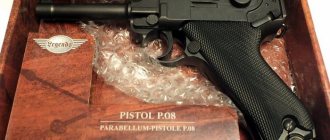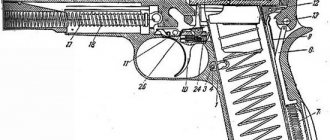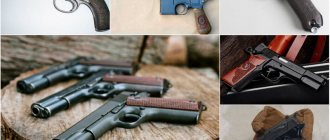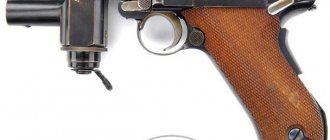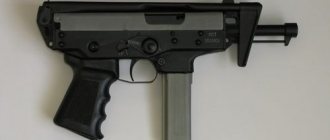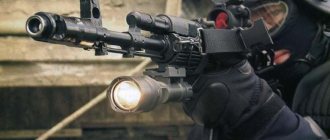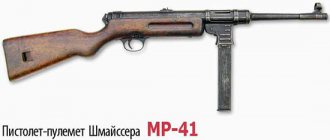Si vis pacem, para bellum — Die Pistole 08 “Parabellum”
Front-line officers, veterans of the NKVD, intelligence and SMERSH are familiar with this pistol. Created at the beginning of the century, designed extremely successfully, went through two world wars and claimed many lives. Parabellum is still used today. For the uninitiated, he is a mystery. The unusual design of the pistol and the stories of those who shot it give rise to legends and speculation about the power of this weapon. Its sinister design has an attractive power. Communication with him can change a person's character. Parabellum is unique. In the entire history of the development of automatic weapons, no one has invented a pistol with a more original, effective and ergonomic design. This weapon system has been arousing the professional interest of combat military personnel, sports shooters, gunsmiths and, naturally, intelligence officers for almost a hundred years.
It so happened that this pistol was designed sequentially by two German engineers. In 1893, inventor Hugo Borchardt patented an automatic pistol with an unusual barrel locking system based on the principle of the dead center of moving parts - the bolt, connecting rod and crank. The mechanical system was calculated mathematically, worked extremely reliably, had a very high accuracy of fire and impressive bullet resistance. But, as gunsmiths know, only beautiful weapons shoot truly well. Borchardt's pistol design was disgusting. There was no weight balance as such, and therefore the pistol, which had a perfect firing from the machine, did not hit at all when fired “from hand.” It was an "ugly duckling", just a working model of a successful engineering idea.
Seven years later, in 1900, Borchardt's theoretical concept was translated into a real weapon system by another German designer, Georg Luger, who completely changed the layout of the weapon. The pistol grip acquired an optimal angle and was orthopedic adjusted to the average size of the shooter’s palm. The designer placed a return spring in the tilted handle, which made it possible to significantly reduce the dimensions of the weapon and the mass of moving parts. It was possible to lower the barrel along the axis as much as possible - and the throwing angle during the shot decreased. The center of gravity shifted forward - and the weapon acquired an impeccable weight balance. The pistol decreased in size, became light and convenient. All this was achieved while maintaining the reliability, accuracy and design power of the system. Georg Luger pursued the goal of creating a portable, ultra-precise and long-range fire weapon for athletes, foresters, hunters and travelers, suitable for survival in difficult conditions, capable of suppressing the enemy at the maximum distance of pistol combat. But that was not all. The pistol was created for commercial purposes - in order to be bought. It was clearly the work of an unknown, but talented designer in his own way. The appearance of this weapon attuned the psyche to the medieval Teutonic cruelty characteristic of German aristocrats. The pistol transmitted to its owner an incomprehensible destructive psychoenergy - it instilled a feeling of offensive aggressiveness in the one who held it in his hands. It received the corresponding commercial name “Parabellum” (from the Latin saying: “Si vis pacem, para bellum” - “If you want peace, prepare for war”). The ugly duckling turned into a kite.
In its civilian commercial version, the Parabellum was produced (and is still produced) with a caliber of 7.65 mm. At one time, it differed favorably in weight, linear and ballistic characteristics from other automatic weapons.
The Kaiser's military, in German, was practical about the original design. They suggested that the inventor increase the caliber of the system to 9 mm and recommended that the pistol be adopted by the Bundeswehr. A 9 mm cartridge with a “cut cone” type bullet (with a flat front platform, crushing the tissue of a living target upon impact and causing shock) was specially developed for the pistol. With the increase in the caliber of the Parabellum, its striking qualities increased so much that they still make an impression in our time. In 1908, this weapon system was adopted by the German army under the code name “Pistol 08m (die Pistole 08). The combat qualities of the new weapon were fully demonstrated in the maneuverable guerrilla and semi-partisan large-scale conflicts that swept across the globe after the First World War. At that time there was no better weapon of this class. "Parabellum" began to be produced in China, Mexico, Iran, Turkey, and Spain. It was in service in Switzerland, Holland, Bulgaria and other countries under the name "Borchardt-Luger".
The automatic operation of the pistol is based on a short rearward stroke of the barrel. The moving system of the weapon consists of a barrel with a receiver, inside which parts of the locking mechanism and the impact mechanism are mounted. The barrel with the front sight on the muzzle is connected to the receiver using a threaded connection. The receiver has the shape of a fork. A bolt with an impact mechanism and an ejector is placed and moved inside the fork. The bolt is articulated with a connecting rod, and the latter with a crank. The bloodworm has a massive tooth that interacts with the beveled surface of the gun frame when braking the moving system after a rollback. The entire hinge-lever connection of the device is a crank mechanism, in which the slide is the bolt. The barrel and receiver, assembled with their parts, can move in the grooves in the longitudinal direction. The crank at the junction with the connecting rod has two rollers with a notched surface, made with it as one whole, which give the weapon an unusual appearance. Two deep cutouts on these frames allow the bloodworm to rest on the receiver so that the axis of the middle hinge becomes lower than the axes of the front and rear hinges.
In the forward position, the bolt is locked, since the connecting rod and the crank form an obtuse angle with each other, with the apex facing down. When fired, the pressure of the powder gases is transmitted through the cartridge case to the bolt. The receiver prevents the obtuse angle between the hinge and the crank from increasing, and under the influence of the recoil force, the entire system described above, when locked, moves back by about 6 mm. Unlocking begins after the bullet leaves the barrel, when the bloodworm rollers “run” onto the profile surfaces of the frame. The crank begins to turn upward with the rollers, the articulated-lever connection quickly passes through the dead position, after which the crank receives a sharp increase in angular velocity, due to the curvilinearity of the profile surfaces. The connecting rod and crank are folded, the shutter opens. When the bolt is opened, the connecting rod cocks the firing pin with a cocking tooth. The crank is connected through a transmission lever to a return spring located in the handle, which returns the moving system to its original position after the recoil energy ceases. When moving forward, the bolt picks up a cartridge from the magazine and sends it into the barrel. When you press the trigger, the transmission lever mounted in the trigger cover acts on the trigger lever disconnector mounted on the receiver. The trigger lever rotates on an axis, releasing the firing pin, which breaks the capsule. A shot is fired and the reloading process begins all over again. When the barrel and receiver move backward relative to the frame, the disconnector “runs” onto the side surface of the transmission lever and is installed inside the body. In this position, shooting is still impossible - you need to release the trigger.
In this case, the transmission lever moves to the side and releases the disconnector, which, under the action of a spring, enters from the release lever housing and becomes under the transmission lever. If you now press the trigger, the shot will repeat. The trigger mechanism allows only single fire. The safety is in the “Gesichert” position - the flag is lowered, the fuse bar blocks the trigger lever. The cocked firing pin is locked very reliably.
To load the Parabellum, press the magazine latch, then remove the magazine and load it with cartridges. We insert the loaded magazine into the handle. The bloodworm grabs the rollers, moves up and down until it stops and is released. The weapon is ready to fire. The presence of a cartridge in the chamber is indicated by the raised position of the ejector. At the same time, the inscription “Geladen” opens - charged. When the last cartridge is used up, the bolt is locked with a slide stop and the moving system stops in the moving position. In order to close the bolt, you need to remove or slightly release the magazine and slightly move the bloodworm back. If there are cartridges in the magazine and the moving system is open, the crank is also fed back behind the rollers - in this case, the bolt comes off the bolt stop.
Parabellum works very reliably. Feeding the cartridge from the magazine into the chamber eliminates distortions and sticking of the cartridges - in the cramped space of the fork of a steel box there is simply nowhere for the cartridge to “turn out”. The gun is not afraid of sand and dust - they are “blown out” upward after a shot from a small opening window in the receiver following the spent cartridge case by the residual pressure of the powder gases. The Parabellum's lifespan is 25 thousand shots. It is interesting that the older and more “spattered” the mechanism is, the softer its recoil and, accordingly, it “throws” less when fired. Due to the inevitable backlash between the parts of the moving system, the recoil impulse acts sequentially on each of them and is not felt so sharply. With a preserved and well-maintained bore, the wear of the mechanism has virtually no effect on the accuracy of the fire.
Care, conservation, cleaning and lubrication of the Parabellum are carried out as usual. It should be taken into account that German weapons steel, unlike Russian steel, “loves to rust.” Therefore, you have to clean it more thoroughly. The Parabellum barrel bore is not chrome plated. The Germans, like us, in those days did not yet know how to chrome-plate barrels. The design of the Parabellum is thought out to the smallest detail and calculated with true German precision. In essence, this is a compact firearm, where the operation of parts and mechanisms is based on the strictest engineering calculations. Each part, its mechanical and weight balance in the process of interaction with other parts and mechanisms, the resistance of the metal, are carefully calculated. From a mechanical point of view, the system is ideal - it uses the maximum energy of the powder charge to eject a bullet and minimally to reload the weapon. This is achieved thanks to the relatively small mass of the shutter and the specificity of its interaction with other moving parts. A weapon system designed only in this way could accelerate a relatively heavy (7.9 g) bullet to a speed of 330 m/sec. short - 85 mm barrel. The barrel itself is drilled to a light taper and machined very cleanly. The accuracy of the Parabellum's combat is absolute and has not yet been surpassed by combat automatic pistols - the spread of bullets at a distance of 25 meters fits into the diameter of a five-kopeck coin. The main model is a short-barreled Parabellum holster that confidently “reaches” a target in the head at a distance of up to 100 meters. Pistols were also produced with a barrel length of 200 mm and an aiming rib, like a rifle, notched at a distance of 300 meters, with an initial speed of a regular bullet of 390 m/sec. With an attached butt-holster, such a pistol was actually a light automatic carbine. There was also a training version of the 5.6 mm Parabellum and a special model with a silencer for silent shooting.
The pistols produced before the war at various factories in Germany were of very high quality, with a large margin of safety with the highest manufacturing precision and impeccable cleanliness of the working surfaces of the parts. “Parabellums”, manufactured in other countries from much worse materials, not made so carefully, also fired quite well - the quality of shooting was determined by the engineering calculations embedded in the design.
The 9×19 cartridges used for firing from the “Parabellum” (they are called “08 Parabellum”), in terms of tactical, technical characteristics and design features, turned out to be perhaps the most practical for automatic pistol operation. The cartridge case of such ammunition slightly tapers from the middle of the body to the muzzle (by 0.3 mm), which ensures easier extraction after firing. With the advent of submachine guns designed for this cartridge, the production of ammunition with a cut-cone bullet ceased, and Germany switched to the production of 08 Parabellum cartridges with an ogive (egg-shaped) bullet, most suitable for the automatic operation of a submachine gun. These cartridges turned out to be so successful that since then they have been used to fire the vast majority of pistol and submachine gun systems. Before the war, the Germans produced a version of this ammunition with a powder charge increased by 20% - the so-called “carbine cartridge 08”. In long-barreled Parabellums, a bullet from such a cartridge accelerated to a speed of 470-500 m/sec.
The features of the mechanism provide the pistol with a higher rate of fire and increased bullet impact on the target at long distances for pistol fire. It was designed for skilled and trained shooters, but even for a novice it is easy to shoot and easy to hit. Thanks to the orthopedic handle, the Parabellum fits in the hand like a glove. The barrel is located low - almost at the level of the shooting hand. The locking system opens upward, and therefore the weapon “knocks down” slightly when fired. From the Parabellum you can fire quickly. Some inconvenience of loading is compensated by the amazing accuracy of shooting - at a line of sight distance in the forest, wherever you aimed, you hit it. Moreover, he hit immediately, with the first shot. This pistol is very good for shooting back, keeping the enemy at a respectful distance. The inclined handle allows you to effectively shoot offhand from the stomach, without aiming, at the silhouette, by ear in the dark. This weapon is ideal when shooting at running targets. The mechanical strength of the pistol allows it to be used as a brass knuckle during hand-to-hand contact. Therefore, "Parabellum" was indispensable for front-line intelligence officers, saboteurs, performers of special missions, mercenaries and terrorists.
Essentially, the Parabellum was the weapon of an aristocratic hunter, but it could only be used to hunt people. His appearance and the physical sensations he evoked aroused feelings of confident superiority and brutal inflexibility in accordance with the fascist theory of the superman. These qualities of the weapon pleased both the sports passion of the German rangers in the fight against poorly armed partisans, and the bloodthirstiness of the SS officials who had fun shooting at civilians.
This pistol did not show itself particularly well at the front. Its accuracy and range turned out to be unclaimed compared to the work of other automatic weapons that solve tactical problems with an increased density of fire. However, our officers did not miss the opportunity to remove the “Parabellum from a killed German - as a personal holster weapon, it was incomparably better than a service TT.”
The operatives, ours and the Germans, did not like Parabellum. It was not suitable for carrying in a pocket, there was no self-cocking, so necessary for a sudden oncoming collision, and it was impossible to use one hand to bring the weapon into the “combat” position. The safety did not turn on inconveniently and did not lock moving parts - when the safety was on, the bolt opened. In case of severe contamination, in the cold, with a defective cartridge, or thickening of the lubricant, the bloodworm did not lock the bolt completely - the disconnector reached the transfer lever, and in this position the locking system stopped, because the force of the return spring was not enough. At long distances this did not matter - to fire a cartridge, it was enough to slam the bloodworm with your hand from above, but at close ranges of a detective battle “at point-blank range” any delay could be the last.
Parabellum was difficult to produce. Its manufacturing technology required a lot of milling operations. Even the store was milled. Therefore, since 1938, the Germans gave preference to the Walter R-38, which was not so accurate and ergonomic, but more practical and adapted to conducting sudden fire at close ranges, although the Parabellum continued to be produced until the last days of the war. I saw such an ersatz pistol made in 1945 with plastic grips and a magazine stamped from roofing iron.
After World War II, production of Parabellum combat pistols was discontinued. It was not modernized - no one managed to create a more advanced automation system. Attempts by other designers to design weapons operating on the same principle were unsuccessful. The concept of the relationship between the design of the Parabellum and the layout of its mechanism remained unsolved. The phenomenon of the impact of the external design of this pistol on the psyche of the shooter has not yet been studied. In many countries, the combat version of the Parabellum has been declared a weapon of targeted destruction and is prohibited for use. Despite the fact that over the past 50 years a huge number of these pistols have been sent for melting down, the Parabellum has survived to this day. Interest in it does not disappear: “Parabellum” is an object of desire for weapons collectors and a hot commodity in military antiques stores. There are such weapons in museums and... in the arsenals of special forces - for particularly precise work.
Nice, but expensive. Very
The Luger's finish is something special. With blued metal parts and handle cheeks made of walnut wood
While listing the advantages of the Luger, one cannot fail to mention its disadvantages. They were, and quite significant. And this is, first of all, the high cost and low manufacturability of the design. In other words, Parabellum was difficult to produce. Its production, for example, took 12.5 man-hours or 778 operations, of which 136 were performed manually.
The consumption of materials was also ineffective. The gun itself, unloaded, weighed 900 grams, and its production required more than 6 kg of metal. Accordingly, the Luger was expensive. The cost of two pistols was equal to a whole Mauser rifle.
Soviet Luger
Parabellums were supplied in fairly large quantities to the Russian army even before the revolution. Well, in the late 30s, it was the design of Georg Luger that prompted the Soviet gunsmith Pavel Voevodin to create his own pistol.
The Vojvodina pistol was conceived as a replacement for the far from perfect TT. "Soviet Luger" successfully passed several stages of testing. But its final refinement and mass implementation were prevented by the beginning of the Great Patriotic War. Source
Trophy value
Still from the TV series Band of brothers
The unusual shape of the Luger, its consumer characteristics, as well as the fact that such pistols were issued to Wehrmacht officers during World War II, made the Parabellum an extremely valuable trophy among the allied forces. This moment, by the way, is perfectly depicted, for example, in the mini-series “Band of Brothers.” What's not a reason to watch the masterpiece from Spielberg and Hanks one more time?!

